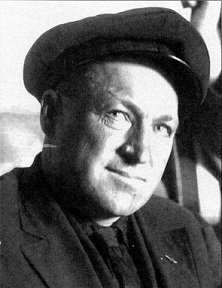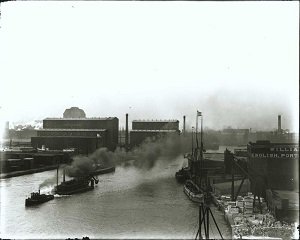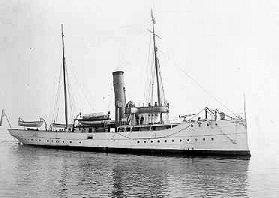Dan Seavey, American Pirate
Dan Seavey, like a lot of other historical figures, straddles the line between fact and legend. If he’d been born fifty years later he’d have been a byline on a police blotter. If he’d have been as wrapped in myth as Davy Crockett or Johnny Appleseed. He was a brawler and a bully, tall and strong and pugnacious. Every town on the shores of the Great Lakes had a story about Dan Seavey, or “Roaring Dan” as he was known. Among them all, one claim stands out – that he was the first and only pirate of the Great Lakes.

Dan was born in Portland, Maine in 1865. As the name would suggest, it was (and still is) a sea port on the coast. Dan’s father was the captain of a schooner, and Dan himself was working on boats from at least a young as thirteen. At eighteen he joined the US Navy for a three year tour, and at the end of that he joined the Bureau of Indian Affairs as a deputy marshal for a time. One story from that time [1] has Dan pursuing a fugitive to the town of Naubinway in Michigan, where he found him holed up in a local saloon. The outlaw told Dan that if the lawman could beat him in a fight, he would come quietly, so the two set to fisticuffs. The fight reportedly went on for hours, with occasional breaks for the two men to fortify themselves with whiskey. Eventually Dan knocked the outlaw to the ground, and then tipped the bar’s piano on top of him. That ended the fight, but the fugitive’s injuries were so severe that he died of them during the night. The next morning Dan telegraphed in his report:
Outlaw expired while resisting arrest.
It might have been this trip to Naubinway that inspired Dan to make the Great Lakes his home, rather than returning to Maine. After leaving the BIA he moved to Wisconsin, where he met and married a young woman named Mary Plumley. The newly married couple move to Wisconsin, where there are records of Dan owning and operating a saloon on the waterfront. In this capacity he reportedly became friends with local beer baron Frederick Pabst (himself a former ship’s captain), and it was Pabst who told him about the fortunes to be made mining gold in Alaska. Dan was drawn by the lure of easy money. He sold his tavern to finance the trip, abandoned his family, and headed off to the Klondike. Like most of those who tried their luck in the gold rush, though, he struck out. He returned to Milwaukee penniless in 1900, though he wasn’t reunited with his family. Instead Mary moved north with their two daughters while Dan moved to Escanaba and remarried.

Dan’s second marriage, to a woman named Zilda Bisner, proved as ill-fated as his first. Zilda filed for divorce in 1904, citing domestic abuse as the reason. Escanaba was where Dan did meet the true love of his life, however – a 42-foot two-masted schooner named the Wanderer. So, when confronted with the divorce papers, Dan simply got on board the schooner and sailed away. It was at this point that Dan became, effectively, of “no fixed abode” – a fancy way of saying the entire Great Lakes became his home. His business was whatever profit a man could turn using a schooner, a willing crew and a complete disregard for both morality and social norms.
The most morally dubious was taking advantage of the inability of local officials to enforce law on the lakes by turning the Wanderer into a floating bordello. He wasn’t alone in this – it was a common dodge, usually combined with serving the customers smuggled liquor. It wasn’t his dealing in sex that was so dubious however, but rather the dark rumours that not every girl working on the Wanderer was there by choice. This combined with another story about Dan’s practises, that of raiding a town’s docks. This involved taking the Wanderer into a port in the dead of the night, with no running lights and as little noise as possible. The crewmen would swarm onto the docks, grab everything not nailed down and run back to the ship before being noticed. The rumours were that the “everything” they grabbed included any woman unfortunate enough to be out on the docks at the time. Whether true or not, it all added to the dark legend of Dan Seavey.
On a lighter note, Dan also moonlighted as a con man. Chicago at the time had a thriving horse racing scene, and it being Chicago the horse owners were looking to find any possible advantage they could in the trade. One supposed surefire way to increase a horse’s stamina was to feed it “marsh hay” harvested in the freshwater marshes in Delta County Michigan. The hay was cheap to harvest but fetched a premium on the Chicago market, and the rumour was that Dan had spread the story of its miraculous properties himself in order to create the trade.

Another profitable trade for Dan was venison smuggling. This brought him into conflict with the Booth Fishing Company. The company had been founded by English immigrant Alfred Booth fifty years earlier, and had taken advantage of the economic crash in 1890 to seize a stranglehold on fishing in the Great Lakes. They were a very unpopular company, with a reputation for buying low through intimidation and selling high through monopoly. They were also thought to be heavily involved in more illicit trades on the lake, and so when Dan Seavey set up a highly profitable business smuggling poached venison into Chicago outside of hunting season, Booth decided that they wanted a piece. They sent a ship full of heavies up to drive Dan out of the area where he was buying the venison, and at first they succeeded. It was while they were on their way back to Chicago that Dan intercepted them. The story says that he had managed to steal a cannon and mount it on the Wanderer’s deck, and with it he blew the boat out from under the disbelieving Chicago gangsters. None of the city men survived, and Dan made it clear that anyone else who tried to take over his operations would suffer the same fate.
Sinking another boat with a cannon may have been only a legend, but the act of piracy that made Dan Seavey famous was no tall tale. It started in a bar in Grand Haven, a port city on the opposite side of Lake Michigan from Milwaukee. Grand Haven was well known as a hub on the lumber trade, with logs coming down on the Grand Trunk railroad to the docks where they were loaded onto ships. One such ship was the Nellie Johnson, and her crew and captain were drinking in that bar in Grand Haven. So was Roaring Dan Seavey. He had some history with RJ McCormick, the aforementioned captain, and the two men got to drinking. But Dan and his men drank sparingly, while the crew of the Nellie Johnson had a thirst on them. Soon they were all passed out, and Dan and his crew headed down to the docks, got into the Nellie Johnson and sailed away. His plan was to take the ship down to Chicago, unload the lumber on the black market, then head up north and sell the ship. By the time he made it to Chicago, though, word had been telegraphed of the theft and nobody wanted to risk buying the cargo. So Dan sailed north, slowed down by the weight of the lumber.

He was pursued by the Tuscarora, a US Revenue gunship which would go on to serve in (and survive) World War 1. Aboard was a US deputy marshal named Tom Currier with a warrant for Dan’s arrest on the charge of piracy, making Dan the only official “pirate” in the history of the Great Lakes. [2] Luckily for Dan he had enough of a head start that the Tuscarora was reduced to searching its way up the coastline – unfortunately for him Preston Uberroth, captain of the ship, had the bright idea of telegraphing all the lighthouses and coast guard stations around the lake to see if they had spotted the Nellie Johnson. One station, at Frankfort, had seen Dan in town. The Tuscarora headed north, stopping just out of sight of the town in order to try and sail up in the night and surprise Dan. That afternoon though they spotted the “Nellie Johnson” sailing out of the harbour, so they gave chase. Legend has it that Dan refused to stop until the gunboat blew a hole in his hull. The Tuscarora’s log makes no mention of this though, and just say that Dan pulled to when hailed. Regardless, Dan was taken south in irons to stand trial.
Piracy was a capital offence, but luckily for Dan since he had once been a crewman on the Nellie Johnson his lawyer was able to get it changed at the indictment to “mutiny and sedition”. Even more luckily, he wound up walking away from court a free man. Rumours abounded that he had represented by a lawyer he had once taken on a hunting trip, who knew exactly who to bribe in order to get the charges dropped. Another story was that his defence of having taken the Nellie Johnson in order to settle a debt was believed by the jury. Or that they pretended to believe it as they didn’t want to be responsible for convicting the legendary Dan Seavey. However it happened, he got off, though not quite scot free. His card was marked, and he wound up being enlisted to act, once again, as a US deputy marshal for a time.

Dan continued to be an established character on the Great Lakes into the 1920s, selling the Wanderer in 1919 and purchasing a gas boat to replace it. Though the Nellie Johnson affair marked the high water mark of his shady enterprises, it did not end them. In 1923 he was involved in a scheme to purchase some land at Gouley’s Harbour and set up a gentleman’s club, though nothing ever came of it. In a possibly related incident around the same time, Dan was involved in a “suspicious” fire at a sawmill in the same town. Two men died in the fire, and though Dan survived he was burned badly enough that he had to quit sailing. He retired to Escanaba, where he became a local curiosity – known for his gruff manner, and his habit of telling tall tales. Local historians recording these tales as fact accounts for a great deal of the confusion around the details of Dan Seavey’s life. He had reconciled with at least one of his daughters, Josephine, and she looked after him as he aged, though eventually he was moved into a nursing home in Peshtigo, Wisconsin. There he died in 1949, aged 85 years old. A peaceful end for a violent man, one of the last of the frontier legends.
Banner via WhooNew.
[1] Dan Seavey was the type of man who inspired tall tales and embellishments, so take all of this stories with a grain of salt.
[2] He does have some competition – James Strang and his followers, a Mormon sect who lived on Beaver Island, were accused of piracy and other crimes. No charge was ever brought against them, though.
